PTR Boys
 At the end of 1934, the UK Ministry of Defense decided that such weapons as an anti-tank rifle must be in service with the army and it is only natural that these weapons should have been of domestic production, that is, English. Understanding that such weapons, despite all their flaws, have one very significant positive quality, such as mobility, the basic requirements that were imposed on weapons were mainly related to ease of handling and transportation, but also the effectiveness of the new anti-tank gun was not the last . Since “cadres decide everything”, then the selection of people participating in the project was treated quite strictly, and Captain Boyce, who was an excellent expert in small arms, headed this disgrace and knew the most important thing from his own experience . The project itself was named Stanchion, and perhaps even the weapon would have been called if the project manager had lived to adopt this anti-tank gun. So, the PTR got its name, in which it perpetuated the name of the project manager, the full name of the anti-tank gun looks like this: Boys Anti-Tank rifle.
At the end of 1934, the UK Ministry of Defense decided that such weapons as an anti-tank rifle must be in service with the army and it is only natural that these weapons should have been of domestic production, that is, English. Understanding that such weapons, despite all their flaws, have one very significant positive quality, such as mobility, the basic requirements that were imposed on weapons were mainly related to ease of handling and transportation, but also the effectiveness of the new anti-tank gun was not the last . Since “cadres decide everything”, then the selection of people participating in the project was treated quite strictly, and Captain Boyce, who was an excellent expert in small arms, headed this disgrace and knew the most important thing from his own experience . The project itself was named Stanchion, and perhaps even the weapon would have been called if the project manager had lived to adopt this anti-tank gun. So, the PTR got its name, in which it perpetuated the name of the project manager, the full name of the anti-tank gun looks like this: Boys Anti-Tank rifle. 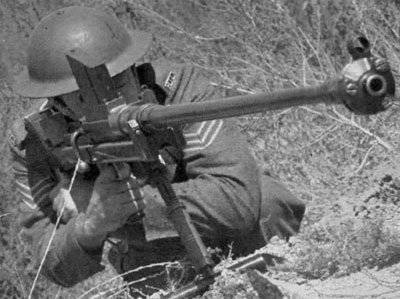 Naturally, the basis of any weapon is the cartridge that is used in it. So, initially the weapon was created around the ammunition with a caliber of 12,7 millimeters from the Vickers machine gun, but this cartridge showed very low characteristics of armor-piercing, as the designers did not distort over its bullet. To solve this problem, it was necessary to create a new ammunition, and in 1936 this ammunition appeared. It was designated differently, but the common name .55Boys is known and understandable to everyone. With a metric designation of 13,9x99, this cartridge is easily recognizable by the circular protrusion in front of the groove on the sleeve. There was already a discussion about this munition in an article about the Rolls-Royce experimental heavy machine gun, but some things can be repeated. The main cartridges for this anti-tank rifle, of course, were armor-piercing ammunition, of which there were two options. The first of them had a bullet weighing 60 grams with a steel core. This bullet was capable of penetrating 16 millimeters of steel from one hundred meters on condition that it fell at an angle of 90 degrees, which, of course, was a very, very low rate, but the ammunition was cheap. The second version of the cartridge with an armor-piercing bullet was more expensive, but its effectiveness increased significantly. So this cartridge was equipped with a 47,6 gram bullet, the bullet core was tungsten. Thanks to its lower weight and core, this bullet pierced up to 20 millimeters of armor at a distance of 100 meters, and the angle of impact was up to 70 degrees, which, of course, wasn’t so good, but the year was 1936. The mass of the cartridge was 133 grams, powder the charge was 13,74. The initial velocity of the bullet of the first version of the armor-piercing cartridge was 760 meters per second, the second variant with a lighter bullet accelerated the bullet to 884 meters per second. These parameters were quite enough to successfully cope with lightly armored enemy vehicles, vehicles, aviation in parking lots, light tanks, enemy manpower behind light shelters and so on.
Naturally, the basis of any weapon is the cartridge that is used in it. So, initially the weapon was created around the ammunition with a caliber of 12,7 millimeters from the Vickers machine gun, but this cartridge showed very low characteristics of armor-piercing, as the designers did not distort over its bullet. To solve this problem, it was necessary to create a new ammunition, and in 1936 this ammunition appeared. It was designated differently, but the common name .55Boys is known and understandable to everyone. With a metric designation of 13,9x99, this cartridge is easily recognizable by the circular protrusion in front of the groove on the sleeve. There was already a discussion about this munition in an article about the Rolls-Royce experimental heavy machine gun, but some things can be repeated. The main cartridges for this anti-tank rifle, of course, were armor-piercing ammunition, of which there were two options. The first of them had a bullet weighing 60 grams with a steel core. This bullet was capable of penetrating 16 millimeters of steel from one hundred meters on condition that it fell at an angle of 90 degrees, which, of course, was a very, very low rate, but the ammunition was cheap. The second version of the cartridge with an armor-piercing bullet was more expensive, but its effectiveness increased significantly. So this cartridge was equipped with a 47,6 gram bullet, the bullet core was tungsten. Thanks to its lower weight and core, this bullet pierced up to 20 millimeters of armor at a distance of 100 meters, and the angle of impact was up to 70 degrees, which, of course, wasn’t so good, but the year was 1936. The mass of the cartridge was 133 grams, powder the charge was 13,74. The initial velocity of the bullet of the first version of the armor-piercing cartridge was 760 meters per second, the second variant with a lighter bullet accelerated the bullet to 884 meters per second. These parameters were quite enough to successfully cope with lightly armored enemy vehicles, vehicles, aviation in parking lots, light tanks, enemy manpower behind light shelters and so on.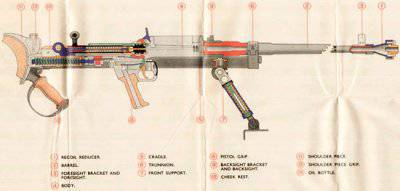 If we disassemble the Boys Anti-Tank rifle anti-tank rifle device, we will not find anything revolutionary at the moment, but at that time, despite its simplicity, it was a very original weapon. The basis of the PTR was a longitudinal sliding bolt locking the barrel bore when turning to 6 lugs. Recharging, of course, was carried out manually, by means of the shutter handle, which was pulled up and bent to the right. It was fed by Boyce’s anti-tank rifle from detachable box magazines with a capacity of five single-row cartridges. An MFR shop was inserted on top of the weapon, which required shifting the aiming devices to the left relative to the anti-tank gun. The trigger mechanism is the simplest that can only be done, although there were variations, but about them a little lower. Much more interesting is the way the recoil was extinguished when the shot was not at all a weak cartridge. Apart from the fact that the muzzle brake-compensator of recoil was installed on the barrel of the weapon, which was not particularly distinguished by its efficiency, especially by modern standards, Boyes’s anti-tank gun was also equipped with a recoil compensation device in the weapon itself. The easiest way to describe the principle of its work for understanding. The basis of the weapon was the frame on which the movable receiver box and bolt was mounted, behind the receiver there was a spring through which the guide rod passed. When fired, the barrel together with the receiver was fed back relative to the weapon frame, while the return spring was compressed, making the recoil more stretched in time and, accordingly, more convenient for the shooter. In addition, the butt of Boyce’s anti-tank rifle had a cushioning pad, which also had a positive effect on the ease of handling the weapon.
If we disassemble the Boys Anti-Tank rifle anti-tank rifle device, we will not find anything revolutionary at the moment, but at that time, despite its simplicity, it was a very original weapon. The basis of the PTR was a longitudinal sliding bolt locking the barrel bore when turning to 6 lugs. Recharging, of course, was carried out manually, by means of the shutter handle, which was pulled up and bent to the right. It was fed by Boyce’s anti-tank rifle from detachable box magazines with a capacity of five single-row cartridges. An MFR shop was inserted on top of the weapon, which required shifting the aiming devices to the left relative to the anti-tank gun. The trigger mechanism is the simplest that can only be done, although there were variations, but about them a little lower. Much more interesting is the way the recoil was extinguished when the shot was not at all a weak cartridge. Apart from the fact that the muzzle brake-compensator of recoil was installed on the barrel of the weapon, which was not particularly distinguished by its efficiency, especially by modern standards, Boyes’s anti-tank gun was also equipped with a recoil compensation device in the weapon itself. The easiest way to describe the principle of its work for understanding. The basis of the weapon was the frame on which the movable receiver box and bolt was mounted, behind the receiver there was a spring through which the guide rod passed. When fired, the barrel together with the receiver was fed back relative to the weapon frame, while the return spring was compressed, making the recoil more stretched in time and, accordingly, more convenient for the shooter. In addition, the butt of Boyce’s anti-tank rifle had a cushioning pad, which also had a positive effect on the ease of handling the weapon. 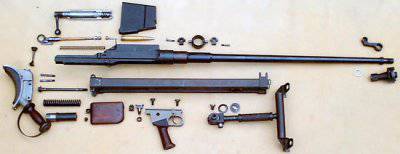 The arms of the arms were folding T-shaped, which made it possible to make the weapon more stable on loose surfaces, such as sand, for example, provided that the weapon had a mass of 16,3 kilograms without cartridges. In spite of his weight, one person could confidently handle an anti-tank rifle, albeit with some difficulties. Significantly facilitated the handling of weapons that Beuys's anti-tank gun had two handles to hold, seemingly inconvenient at first glance, but in fact they gave full control over the weapon. The length of the anti-gun was 1626 millimeters, while the barrel length was equal to 910 millimeters. But this is only one version of Boyes’s anti-tank rifle.
The arms of the arms were folding T-shaped, which made it possible to make the weapon more stable on loose surfaces, such as sand, for example, provided that the weapon had a mass of 16,3 kilograms without cartridges. In spite of his weight, one person could confidently handle an anti-tank rifle, albeit with some difficulties. Significantly facilitated the handling of weapons that Beuys's anti-tank gun had two handles to hold, seemingly inconvenient at first glance, but in fact they gave full control over the weapon. The length of the anti-gun was 1626 millimeters, while the barrel length was equal to 910 millimeters. But this is only one version of Boyes’s anti-tank rifle.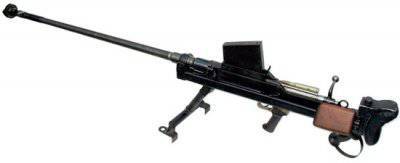 In addition to Britain, the production of these weapons was also established in Canada, but already during the Second World War. The name of the weapon practically did not change, only an asterisk was added - Boys Mk I *. Externally, the weapon differed bipods of a slightly different design, as well as a muzzle brake-compensator, which became flat. In addition, sights were changed, which were made even more to the left in relation to the anti-tank rifle. According to its characteristics, the weapon was no different from the English version. It should be noted that despite the fact that the barrel and receiver were movable, the Boyes MFR was a relatively accurate weapon and allowed firing at a distance of up to 500 meters, which naturally required experience in dealing with not the easiest MFR. The most striking example of the fact that the weapon was accurate can be the fact that the PTR was often used not for its intended purpose and being in capable hands easily assumed the tasks of a sniper rifle, with not very high precision, of course, but in the full sense of the word "Slaughter" result of hitting.
In addition to Britain, the production of these weapons was also established in Canada, but already during the Second World War. The name of the weapon practically did not change, only an asterisk was added - Boys Mk I *. Externally, the weapon differed bipods of a slightly different design, as well as a muzzle brake-compensator, which became flat. In addition, sights were changed, which were made even more to the left in relation to the anti-tank rifle. According to its characteristics, the weapon was no different from the English version. It should be noted that despite the fact that the barrel and receiver were movable, the Boyes MFR was a relatively accurate weapon and allowed firing at a distance of up to 500 meters, which naturally required experience in dealing with not the easiest MFR. The most striking example of the fact that the weapon was accurate can be the fact that the PTR was often used not for its intended purpose and being in capable hands easily assumed the tasks of a sniper rifle, with not very high precision, of course, but in the full sense of the word "Slaughter" result of hitting.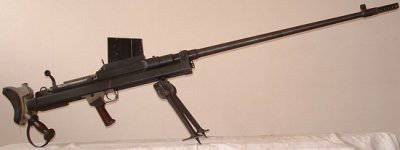 In 1942, another version of this weapon appeared with the designation Mk II. This model was significantly reduced weight and shortened barrel, designed specifically for arming the airborne troops, but by this time the anti-tank guns were no longer relevant as a means of fighting armored vehicles, because the Mk II did not receive as widespread as the first weapon . Around the same time, another prototype was created, this time a prototype based on Beuys’s anti-tank rifle, which stood out because its barrel was a conical drill, but this specimen remained experienced, although it showed better results than the original weapon.
In 1942, another version of this weapon appeared with the designation Mk II. This model was significantly reduced weight and shortened barrel, designed specifically for arming the airborne troops, but by this time the anti-tank guns were no longer relevant as a means of fighting armored vehicles, because the Mk II did not receive as widespread as the first weapon . Around the same time, another prototype was created, this time a prototype based on Beuys’s anti-tank rifle, which stood out because its barrel was a conical drill, but this specimen remained experienced, although it showed better results than the original weapon.Our compatriots had to get acquainted with this weapon for the first time when it was sent in their direction during the Soviet-Finnish war in 1939-1940. Then this weapon was designated as 14 mm pst kiv / 37 it was supplied by the UK. But even during World War II, this weapon could often be found in the hands of the enemy under the name 13.9-mm Panzeradwehrbuchse 782 (e), as a trophy, which suggests that Boyes's MTR was far from the worst. In the USSR, it was also possible to evaluate this weapon, since 1100 MFT units under Lend-Lease were transferred. The whole list of countries where this weapon was used was quite voluminous, and if there were still those countries where this PTR was on semi-legal rights, then this PTR can easily compete with the most common firearm samples. In total, about 69000 units of PTR were created before the 1943 of the year, which, even when adjusted for war, is a decent figure. The track record of weapons in World War II does not end there. So, Boyce's anti-tank rifle was used extensively in Korea, the Philippines, and the last time it lit up in the Congo in 1964-65. And this is only according to official data. "Civilized" Europe abandoned this model in the 1943 year, preferring grenade launchers. Here is an interesting and already forgotten weapon was created under the leadership of Captain Beuys.

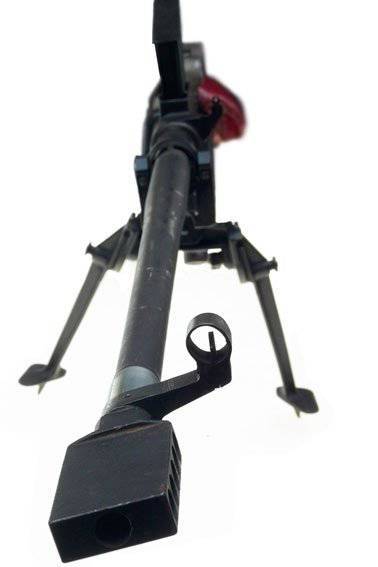
Information